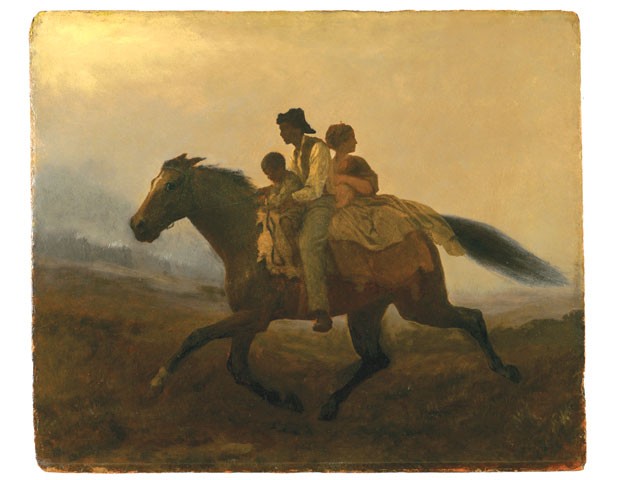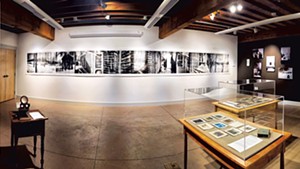
Jane Williamson used to watch wistfully as tour buses tooled past the Rokeby Museum in Ferrisburgh, where she has worked as director for the past 18 years.
A designated national historic landmark, Rokeby was a stopping point 175 years ago — not for tourists but for African Americans fleeing bondage in the South and seeking safe haven in northern, antislavery states such as Vermont. Rokeby, the name the abolitionist Robinson family gave the Ferrisburgh homestead, served as an important way station on the clandestine route to freedom referred to figuratively as the Underground Railroad.
The documents and artifacts housed at Rokeby can enhance visitors’ understanding of the United States slave trade, and of the radical opposition to it. Trouble is, few tourists come to the 225-year-old house, which Williamson describes as “delicate and tiny.” Rokeby has no public toilets, and the water in the home isn’t drinkable.
All that is about to change. Tour buses will likely start pulling into Rokeby soon after the official May 19 opening of a new 2500-square-foot exhibition center. Road trippers will be pleased to discover that the $900,000 cost of construction covered the installation of toilets and a drinking fountain.
The main attraction is a multimedia display that Williamson hopes will boost the total yearly visitors from 1000 to as many as 5000. Titled “Free & Safe: The Underground Railroad in Vermont,” the exhibit shifts the museum’s focus away from the Quaker family who lived at Rokeby and toward two fugitive slaves, Simon and Jesse, whom the Robinsons helped.
“We’re now talking more about the black fugitive experience and less about the white assistance,” Williamson says. “We’ve made Simon and Jesse the stars of the show.”?
The decision to base the exhibit on a pair of partly imagined narratives stemmed from Williamson’s realization that “it’s the story of the Underground Railroad that drives visitation.” Tourists generally aren’t keen to view 175-year-old letters in crowded, sweltering conditions, she says. But Williamson is betting they will spend time viewing a visually compelling display that also features audio accounts of experiences that Simon and Jesse may have had at Rokeby. There’s nothing like the new Rokeby exhibit’s examination of the Underground Railroad anywhere else in the United States, Williamson points out.
The museum director, as well as the exhibit itself, adds the disclaimer that the stories of the two fugitives are partly speculative. Not much is known about Simon and Jesse — not even their last names. There’s no evidence that Simon, who escaped from captivity in Maryland, ever actually came to Rokeby, Williamson acknowledges — although, she adds, it’s likely that he did. In addition, no one knows what happened to him or to Jesse, a fugitive from North Carolina who is documented as having worked for Robinson at Rokeby for one year.
Jesse’s circumstances are persuasively imagined in a 15-minute audio dramatization by Vermont playwright David Budbill. Using records still housed in the original Rokeby building, Budbill created dialogue involving Robinson, Jesse and another former slave who lived at Rokeby. The tension arises from Robinson’s documented refusal to lend Jesse $150 that would have enabled him to purchase a “freedom paper” from his former owner, Ephraim Elliott. Robinson indicated that his principle of avoiding even indirect involvement in the slave trade prevented him from paying the price Elliott demanded for a deed certifying Jesse’s manumission.
The display in the new building — financed mainly by federal grants and a $500,000 gift from the J. Warren & Lois McClure Foundation — situates the fugitives’ stories firmly within the historical context of slavery and abolitionism. Without that element, Williamson says, visitors to Rokeby, including local schoolchildren, might not fully appreciate its significance. They might also be unable to draw the intended inference that “race remains an issue in today’s Vermont,” Williamson adds.
“Free & Safe: The Underground Railroad in Vermont” is on view May 19 through October 27 at the Rokeby Museum, 4334 Route 7, in Ferrisburgh. Info, 877-3406. rokeby.org










Comments
Comments are closed.
From 2014-2020, Seven Days allowed readers to comment on all stories posted on our website. While we've appreciated the suggestions and insights, right now Seven Days is prioritizing our core mission — producing high-quality, responsible local journalism — over moderating online debates between readers.
To criticize, correct or praise our reporting, please send us a letter to the editor or send us a tip. We’ll check it out and report the results.
Online comments may return when we have better tech tools for managing them. Thanks for reading.